This is an AI Free Zone! Text created by Large Language Models is spreading rapidly across the Internet. It's well-written, artificial, frequently inaccurate. If you find a mistake on Spaceweather.com, rest assured it was made by a real human being. | | |
LYRID METEOR ALERT: The first significant meteor shower in months is about to begin. The annual Lyrid meteor shower peaks on the night of April 21-22 when Earth passes through a stream of debris from Comet Thatcher (C/1861 G1). These meteors are best seen from the northern hemisphere where the radiant is high in the sky before dawn: sky map.
THIS IS THE WORST TIME TO OBSERVE 'THE DEVIL COMET': If you get your science news from mainstream media, you might think this weekend is a great time to observe Comet 12P/Pons-Brooks, a.k.a. "The Devil Comet." In fact, the opposite is true. The comet--barely a naked eye object on the best of nights--is almost completely overwhelmed by a combination of evening twilight and full Moonlight.
To illustrate the problem, Mike Olason photographed the comet sinking into the haze near of Tucson, Arizona, on April 20th:
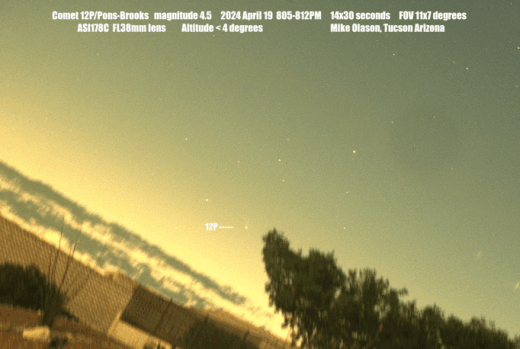
"As one can see from the animation, the images were collected as twilight started to fade only to be replaced by moonshine from the 87% illuminated Moon," says Olason. "It also did not help that the comet was at an altitude below 6 degrees. Most of the tail and coma were washed out by light pollution, twilight, Moonlight and atmospheric interference."
The kernel of truth in mainstream reports is that Comet 12P is at perihelion on April 21st--its closest approach to the sun. Solar heat is indeed brightening the comet to its maximum luminosity. However, Earth and the comet are far apart on opposite sides of the sun, and we have to squint through the glare of the sun to see the comet.
It all adds up to poor visibility--for now. In May the comet will move away from the sun and into the night skies of the southern hemisphere. In fact, astronomer Michael Mattiazzo is already seeing it from Australia.
Realtime Comet Photo Gallery
Free: Spaceweather.com Newsletter
YOU'RE GOING TO WANT TO CLICK ON THIS IMAGE: The white-light sun is a blinding ball of featureless light. But... if you filter the light, and look only at the narrow range of wavelengths emitted by hydrogen, the true sun is revealed. This weekend in Kentucky, amateur astronomer Richard Schrantz used a spectroheliograph to do just that, and here is what he saw:
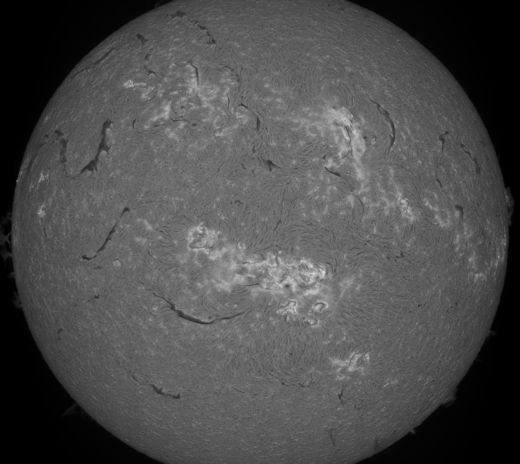
Click on the image for full resolution--and "make sure you look using a large desktop monitor," says Schrantz. "The sunspot complex centered on AR3645 has lots of fine detail."
A spectroheliograph is a special telescope which can photograph the sun at a single narrow wavelength of light--in this case, the "H-alpha" wavelength emitted by solar hydrogen. Schrantz's spectroheliograph image reveals not only a large number of sunspots, but also an even larger number of filaments--magnetic tubes filled with dense hydrogen snaking across the solar disk. These filaments can erupt to produce solar flares and CMEs much like sunspots do; they significantly boost the odds of solar activity. Solar flare alerts: SMS Text
Realtime Space Weather Photo Gallery
Free: Spaceweather.com Newsletter
18K GOLD TOTAL ECLIPSE PENDANT: This pendant has touched the shadow of the Moon. On April 8, 2024, during a total eclipse of the sun in Texas, the students of Earth to Sky Calculus launched it to the stratosphere onboard a cosmic ray research balloon. Floating more than 118,110 feet high, the locket spent 3 minutes and 45 seconds wrapped in lunar shadow:
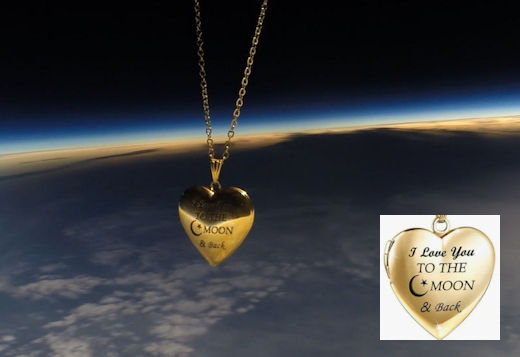
You can have it for $199.95. The 18K gold-plated locket is inscribed with the words "I love you to the Moon and back," and opens to hold a personal photo or other small item. It comes with a greeting card showing the locket in flight and telling the story of its journey to the edge of space during the total eclipse.
Far Out Gifts: Earth to Sky Store
All sales support hands-on STEM education
Realtime Aurora Photo Gallery
Free: Spaceweather.com Newsletter
Realtime Comet Photo Gallery
Free: Spaceweather.com Newsletter
Every night, a network of
NASA all-sky cameras scans the skies above the United States for meteoritic fireballs. Automated software maintained by NASA's Meteoroid Environment Office calculates their orbits, velocity, penetration depth in Earth's atmosphere and many other characteristics. Daily results are presented here on Spaceweather.com.
On Apr 21, 2024, the network reported 3 fireballs.
(3 Lyrids)
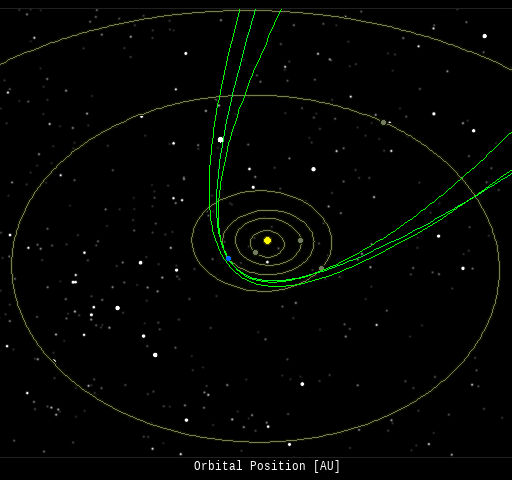
In this diagram of the inner solar system, all of the fireball orbits intersect at a single point--Earth. The orbits are color-coded by velocity, from slow (red) to fast (blue). [Larger image] [movies]
Potentially Hazardous Asteroids (
PHAs) are space rocks larger than approximately 100m that can come closer to Earth than 0.05 AU. None of the known PHAs is on a collision course with our planet, although astronomers are finding
new ones all the time.
On April 21, 2024 there were 2349 potentially hazardous asteroids.
 |
Recent & Upcoming Earth-asteroid encounters: | Asteroid | Date(UT) | Miss Distance | Velocity (km/s) | Diameter (m) |
| 2024 GK6 | 2024-Apr-16 | 8 LD | 8.3 | 15 |
| 2024 GN2 | 2024-Apr-16 | 1.2 LD | 18.5 | 19 |
| 2024 HA | 2024-Apr-16 | 0 LD | 19.5 | 2 |
| 2024 GF3 | 2024-Apr-16 | 13.9 LD | 12.9 | 25 |
| 2024 GS5 | 2024-Apr-16 | 1.8 LD | 18.3 | 22 |
| 2024 GM1 | 2024-Apr-17 | 3.5 LD | 10.4 | 27 |
| 2024 HO | 2024-Apr-17 | 0.5 LD | 10.2 | 6 |
| 2024 GF5 | 2024-Apr-17 | 9.7 LD | 7.4 | 12 |
| 2024 FF4 | 2024-Apr-18 | 16.1 LD | 13 | 51 |
| 2024 GJ6 | 2024-Apr-18 | 2.5 LD | 8.1 | 9 |
| 2024 GA6 | 2024-Apr-18 | 2.7 LD | 7.1 | 12 |
| 2023 HU3 | 2024-Apr-18 | 15.9 LD | 19.1 | 35 |
| 2024 GL5 | 2024-Apr-18 | 16.7 LD | 11.7 | 26 |
| 2024 FU4 | 2024-Apr-19 | 19.2 LD | 7.5 | 29 |
| 2024 GP7 | 2024-Apr-19 | 7.4 LD | 3.6 | 11 |
| 2021 JW2 | 2024-Apr-19 | 1.6 LD | 5.1 | 11 |
| 2024 HQ | 2024-Apr-19 | 0.8 LD | 7.5 | 5 |
| 2017 SA20 | 2024-Apr-19 | 3.8 LD | 6.2 | 8 |
| 2024 FT4 | 2024-Apr-19 | 19.3 LD | 5.2 | 21 |
| 2024 HL | 2024-Apr-19 | 4.8 LD | 19.7 | 17 |
| 2024 GD5 | 2024-Apr-20 | 13.8 LD | 4.5 | 14 |
| 2024 GF6 | 2024-Apr-20 | 2.3 LD | 8.2 | 15 |
| 2024 HR | 2024-Apr-20 | 19.1 LD | 17.7 | 44 |
| 2024 HD | 2024-Apr-21 | 5.9 LD | 5.6 | 14 |
| 2024 GM | 2024-Apr-21 | 18.7 LD | 10.8 | 89 |
| 2024 GW3 | 2024-Apr-21 | 19.5 LD | 13.3 | 39 |
| 2024 HY | 2024-Apr-22 | 5.7 LD | 9.2 | 76 |
| 2024 HS | 2024-Apr-23 | 19.5 LD | 5.7 | 26 |
| 2021 VH2 | 2024-Apr-25 | 9.3 LD | 2.7 | 6 |
| 2024 FG5 | 2024-Apr-26 | 12.5 LD | 9.1 | 35 |
| 2024 HT | 2024-Apr-26 | 17.3 LD | 9.4 | 30 |
| 2024 GR1 | 2024-Apr-27 | 19.6 LD | 7.2 | 52 |
| 2024 GS4 | 2024-Apr-28 | 10.6 LD | 12.8 | 33 |
| 2024 GK5 | 2024-Apr-29 | 12.9 LD | 5.2 | 39 |
| 2021 GD3 | 2024-Apr-30 | 11.2 LD | 3.5 | 14 |
| 2022 TN1 | 2024-Apr-30 | 18.6 LD | 17.7 | 314 |
| 2022 AA5 | 2024-May-02 | 12 LD | 8.9 | 67 |
| 2024 FR5 | 2024-May-05 | 4.9 LD | 5.2 | 49 |
| 2021 JG9 | 2024-May-10 | 16.9 LD | 16.1 | 32 |
| 2016 FT14 | 2024-May-10 | 19.9 LD | 5.9 | 39 |
| 2015 KJ19 | 2024-May-14 | 15.8 LD | 23.1 | 112 |
| 2014 WF6 | 2024-May-14 | 7.2 LD | 18.9 | 47 |
| 2021 JN10 | 2024-May-14 | 17.5 LD | 13.2 | 33 |
| 2021 JJ | 2024-May-15 | 17.2 LD | 5.8 | 28 |
| 2022 WN2 | 2024-May-17 | 13.7 LD | 5.5 | 6 |
| 2019 VB5 | 2024-May-21 | 7.8 LD | 6.3 | 2 |
| 2024 HP | 2024-May-24 | 15.6 LD | 7.6 | 209 |
| 2008 LD | 2024-May-28 | 7.7 LD | 4.5 | 6 |
| 2021 LV | 2024-May-29 | 12 LD | 15.5 | 9 |
| 1998 KY26 | 2024-Jun-01 | 12 LD | 5.3 | 25 |
| 2016 JC6 | 2024-Jun-01 | 19.9 LD | 7.1 | 188 |
| 2008 YN2 | 2024-Jun-05 | 10.5 LD | 7.7 | 20 |
| 2021 LW3 | 2024-Jun-06 | 9.7 LD | 9.8 | 86 |
| 2024 CR9 | 2024-Jun-11 | 19.2 LD | 7.4 | 447 |
| 2022 XC1 | 2024-Jun-12 | 16.5 LD | 6.5 | 21 |
| 2022 WW11 | 2024-Jun-17 | 19.7 LD | 14.4 | 15 |
Notes: LD means "Lunar Distance." 1 LD = 384,401 km, the distance between Earth and the Moon. 1 LD also equals 0.00256 AU. | | Cosmic Rays in the Atmosphere |
SPACE WEATHER BALLOON DATA: Almost once a week, Spaceweather.com and the students of Earth to Sky Calculus fly space weather balloons to the stratosphere over California. These balloons are equipped with sensors that detect secondary cosmic rays, a form of radiation from space that can penetrate all the way down to Earth's surface. Our monitoring program has been underway without interruption for 7 years, resulting in a unique dataset of in situ atmospheric measurements.
Latest results (July 2022): Atmospheric radiation is decreasing in 2022. Our latest measurements in July 2022 registered a 6-year low:
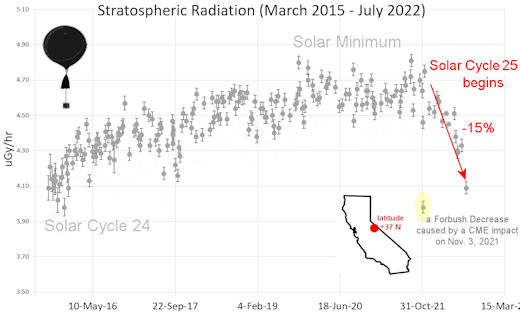
What's going on? Ironically, the radiation drop is caused by increasing solar activity. Solar Cycle 25 has roared to life faster than forecasters expected. The sun's strengthening and increasingly tangled magnetic field repels cosmic rays from deep space. In addition, solar coronal mass ejections (CMEs) sweep aside cosmic rays, causing sharp reductions called "Forbush Decreases." The two effects blend together to bring daily radiation levels down.
.Who cares? Cosmic rays are a surprisingly "down to Earth" form of space weather. They can alter the chemistry of the atmosphere, trigger lightning, and penetrate commercial airplanes. According to a study from the Harvard T.H. Chan school of public health, crews of aircraft have higher rates of cancer than the general population. The researchers listed cosmic rays, irregular sleep habits, and chemical contaminants as leading risk factors. A number of controversial studies (#1, #2, #3, #4) go even further, linking cosmic rays with cardiac arrhythmias and sudden cardiac death.
Technical notes: The radiation sensors onboard our helium balloons detect X-rays and gamma-rays in the energy range 10 keV to 20 MeV. These energies span the range of medical X-ray machines and airport security scanners.
Data points in the graph labeled "Stratospheric Radiation" correspond to the peak of the Regener-Pfotzer maximum, which lies about 67,000 feet above central California. When cosmic rays crash into Earth's atmosphere, they produce a spray of secondary particles that is most intense at the entrance to the stratosphere. Physicists Eric Regener and Georg Pfotzer discovered the maximum using balloons in the 1930s and it is what we are measuring today.
| | The official U.S. government space weather bureau |
| | The first place to look for information about sundogs, pillars, rainbows and related phenomena. |
| | Researchers call it a "Hubble for the sun." SDO is the most advanced solar observatory ever. |
| | 3D views of the sun from NASA's Solar and Terrestrial Relations Observatory |
| | Realtime and archival images of the Sun from SOHO. |
| | information about sunspots based on the latest NOAA/USAF Active Region Summary |
| | current counts of failed and deployed Starlink satellites from Jonathan's Space Page. See also, all satellite statistics. |
| | Authoritative predictions of space junk and satellite re-entries |
| | from the NOAA Space Environment Center |
| | fun to read, but should be taken with a grain of salt! Forecasts looking ahead more than a few days are often wrong. |
| | from the NOAA Space Environment Center |
| | the underlying science of space weather |
 | Marketing yourself on YouTube is hard without real organic views on your videos. You can buy organic YouTube views from and enjoy social boosting that is actually real. Highly recommended! |
 | When looking for casinos to play online when the weather is bad, you can try the SkyCity Online Casino if you are located in New Zealand. If you are not from NZ you can try the Swedish page Svenska casino online to find suitable games, check out svenskacasinoonline.net. Always check your local laws before playing with real money.. |
 | BestCSGOGambling is the best site for everything related to CSGO gambling on the web |
| | These links help Spaceweather.com stay online. Thank you to our supporters! |
| | | | | | |

